A 28-nm CMOS Low-Power/Low-Voltage 60-GHz LNA for High-Speed Communication
Abstract
1. Introduction
2. LNA Design
3. Integration Technology and Passive Component Design
Passive Component Design
4. Layout Description and Expected Performance
4.1. Layout and EM Post-Layout Analysis
4.2. Expected Performance
5. Conclusions: Main Achievements, Pioneering Research and Future Directions
- Integration with OOK demodulator to evaluate complete receiver performance in terms of sensitivity and energy per bit.
- Exploration of reconfigurable bandwidth or gain control via tunable passive elements for adaptive communication environments.
- Investigation into co-design strategies for ESD and matching, to reduce area and further improve robustness without degrading performance.
- Scalability to higher frequencies by redesigning transformers and layout techniques while managing increased losses and EM coupling.
Author Contributions
Funding
Data Availability Statement
Conflicts of Interest
References
- Rappaport, T.S.; Murdock, J.N.; Gutierrez, F. State of the art in 60-GHz integrated circuits and systems for wireless communications. Proc. IEEE 2011, 99, 1390–1436. [Google Scholar] [CrossRef]
- Ferschischi, A.; Rehman, S.U.; Rieß, V.; Carta, C.; Ellinger, F. 20 Gb/s 60-GHz OOK receiver for high-data-rate short-range wireless communications. In Proceedings of the 2020 15th European Microwave Integrated Circuits Conference (EuMIC), Utrecht, The Netherlands, 10–15 January 2021; pp. 45–48. [Google Scholar]
- Byeon, C.W.; Yoon, C.H.; Park, C.S. A 67-mW 10.7-Gb/s 60-GHz OOK CMOS transceiver for short-range wireless communications. IEEE Trans. Microw. Theory Tech. 2013, 61, 3391–3401. [Google Scholar] [CrossRef]
- Ferchischi, A.; Rehman, S.U.; Carta, C.; Ellinger, F. 22-Gb/s 60-GHz OOK demodulator in 0.13-µm SiGe BiCMOS for ultra-high-speed wireless communication. In Proceedings of the IEEE MTT-S International Microwave Symposium (IMS), Boston, MA, USA, 2–7 June 2019; pp. 247–250. [Google Scholar]
- Zhu, F.; Hong, W.; Liang, W.-F.; Chen, J.; Jiang, X.; Yan, P.; Wu, K. A low-power low-cost 45-ghz ook transceiver system in 90-nm CMOS for multi-Gb/s transmission. IEEE Trans. Microw. Theory Tech. 2014, 62, 2105–2117. [Google Scholar] [CrossRef]
- Lin, F.; Brinkhoff, J.; Kang, K.; Pham, D.D.; Yuan, X. A low power 60GHz OOK transceiver system in 90 nm CMOS with innovative onchip AMC antenna. In Proceedings of the IEEE Asian Solid-State Circuits Conference, Taipei, Taiwan, 6–18 November 2009; pp. 349–352. [Google Scholar]
- Lee, J.J.; Byeon, C.W.; Eun, K.C.; Oh, I.Y.; Park, C.S. Gbps 60 GHz CMOS OOK modulator and demodulator. In Proceedings of the IEEE Compound Semiconductor Integrated Circuit Symposium (CSICS), Monterey, CA, USA, 3–6 October 2010; pp. 145–149. [Google Scholar]
- Byeon, C.W.; Eun, K.C.; Park, C.S. A 2.65-pJ/Bit 12.5-Gb/s 60-GHz OOK CMOS transmitter and receiver for proximity communications. IEEE Trans. Microw. Theory Tech. 2020, 68, 2902–2910. [Google Scholar]
- Byeon, C.W.; Lee, J.J.; Eun, K.C.; Park, C.S. A 60 GHz 5 Gb/s Gain-Boosting OOK demodulator in 0.13 μm CMOS. IEEE Microw. Wirel. Compon. Lett. 2011, 21, 101–103. [Google Scholar] [CrossRef]
- Uzunkol, M.; Shin, W.; Rebeiz, G.M. Design and analysis of a low-power 3–6-Gb/s 55-GHz OOK receiver with high-temperature performance. IEEE Trans. Microw. Theory Tech. 2012, 60, 3263–3271. [Google Scholar] [CrossRef]
- Eghtesadi, M.; Giustolisi, G.; Ballo, A.; Pennisi, S.; Ragonese, E. A 5 mW 28 nm CMOS low-noise amplifier with transformer-based electrostatic discharge protection for 60 GHz applications. Electronics 2024, 13, 4285. [Google Scholar] [CrossRef]
- Spataro, S.; Salerno, N.; Papotto, G.; Ragonese, E. The effect of a metal PGS on the Q-Factor of spiral inductors for RF and mm-wave applications in a 28-nm CMOS technology. Int. J. RF Microw. Comput. Aided Eng. 2020, 30, e22368. [Google Scholar] [CrossRef]
- Bevilacqua, A. fundamentals of integrated transformers: From principles to applications. IEEE Solid-State Circuits Mag. 2020, 12, 86–100. [Google Scholar] [CrossRef]
- Huang, C.C.; Kuo, H.C.; Huang, T.H.; Chuang, H.R. Low-power, high-gain V-band CMOS low noise amplifier for microwave radiometer applications. IEEE Microw. Wirel. Compon. Lett. 2011, 21, 104–106. [Google Scholar] [CrossRef]
- Gramegna, G.; Paparo, P.; Erratico, P.G.; De Vita, P. A sub-1dB NF ±2.3kV ESD-protected 900-MHz CMOS LNAs. IEEE J. Solid-State Circuits 2001, 36, 1010–1017. [Google Scholar] [CrossRef]
- Hsu, M.-T.; Lin, Y.-H.; Yang, J.-C. Design of UWB CMOS LNA based on current-reused topology and forward body-bias for high figure of merit. In Proceedings of the 2013 Asia-Pacific Microwave Conference (APMC), Seoul, Republic of Korea, 5–8 November 2013; pp. 772–774. [Google Scholar]
- Asgaran, S.; Deen, M.J.; Chen, C. -H. Design of the input matching network of RF CMOS LNAs for low-power operation. IEEE Trans. Circuits Syst. I Regul. Pap. 2007, 54, 544–554. [Google Scholar] [CrossRef]
- Fritsche, D.; Tretter, G.; Carta, C.; Ellinger, F. Millimeter-wave low-noise amplifier design in 28-nm low-power digital CMOS. IEEE Trans. Microw. Theory Tech. 2015, 63, 1910–1922. [Google Scholar] [CrossRef]
- Lin, C.Y.; Chu, L.W.; Ker, M.D. ESD protection design for 60-GHz LNA with inductor-triggered SCR in 65-nm CMOS process. IEEE Trans. Microw. Theory Tech. 2012, 60, 714–723. [Google Scholar] [CrossRef]
- Han, A.; Luo, X. A 60-GHz current-reused cascode noise-canceling low noise amplifier. IEEE Trans. Circuits Syst. II Express Briefs 2024, 71, 4809–4813. [Google Scholar] [CrossRef]
- Bierbuesse, D.; Negra, R. 60 GHz variable gain & linearity enhancement LNA in 65 nm CMOS. In Proceedings of the IEEE Radio Frequency Integrated Circuits Symposium, Los Angeles, CA, USA, 4–6 August 2020; pp. 163–166. [Google Scholar]
- Cheng, D.; Chen, X.; Chen, Q.; Li, L. Design of an ultra-compact 60-GHz bi-directional amplifier in 65-nm CMOS. IEEE Microw. Wirel. Compon. Lett. 2022, 32, 343–346. [Google Scholar] [CrossRef]
- Ke, J.; Feng, G.; Wang, Y. A compact 60 GHz LNA with 22.7-dB gain and 4.4-dB NF in 40 nm CMOS. In Proceedings of the IEEE International Conference on Integrated Circuits, Technologies and Applications, Xi’an, China, 28–30 October 2022; pp. 152–153. [Google Scholar]
- Nawaz, A.A.; Albrecht, J.D.; Ulusoy, A.C. A 28-/60-GHz band switchable bidirectional amplifier for reconfigurable mm-wave transceivers. IEEE Trans. Microw. Theory Tech. 2020, 68, 3197–3205. [Google Scholar] [CrossRef]




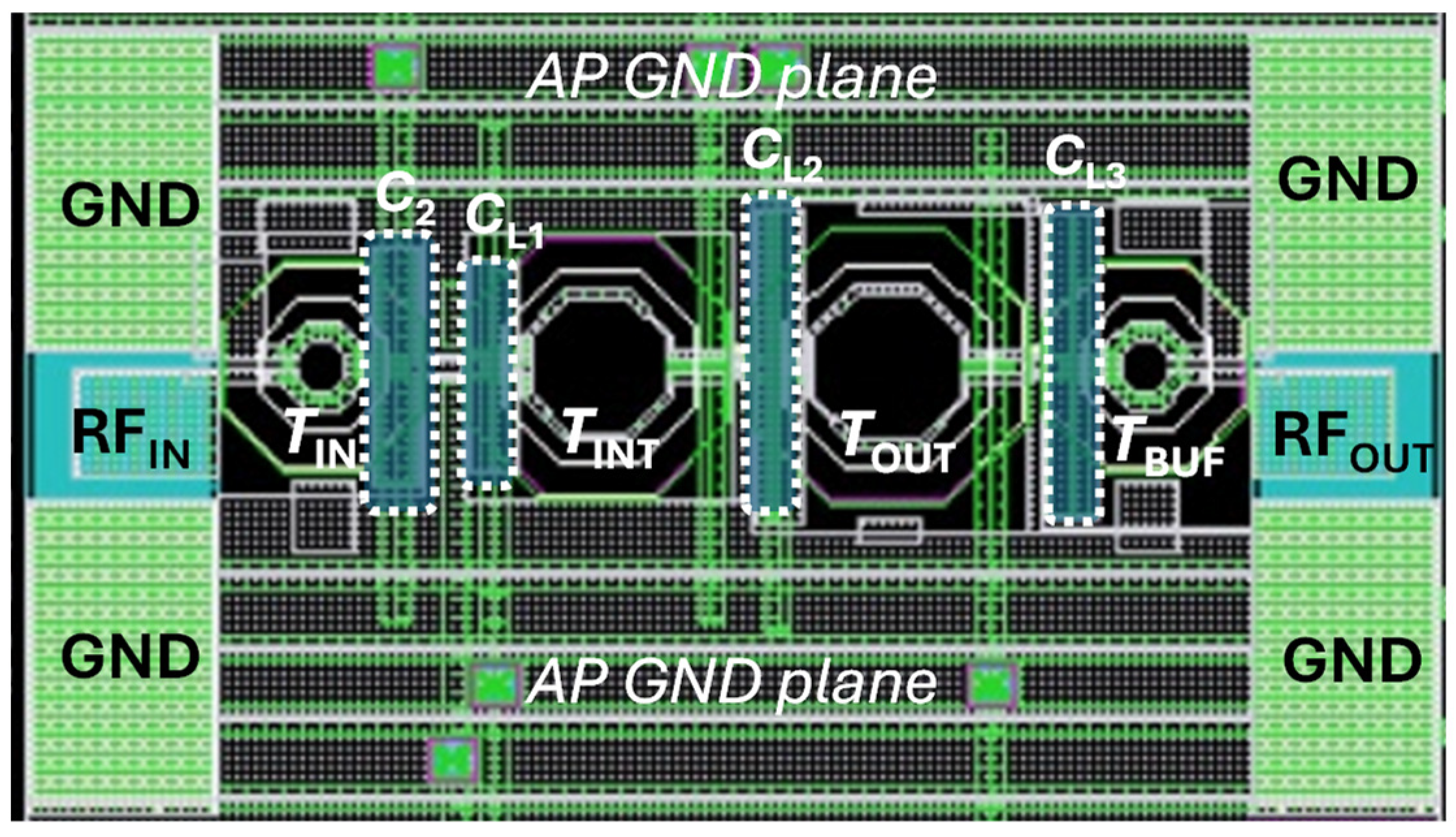

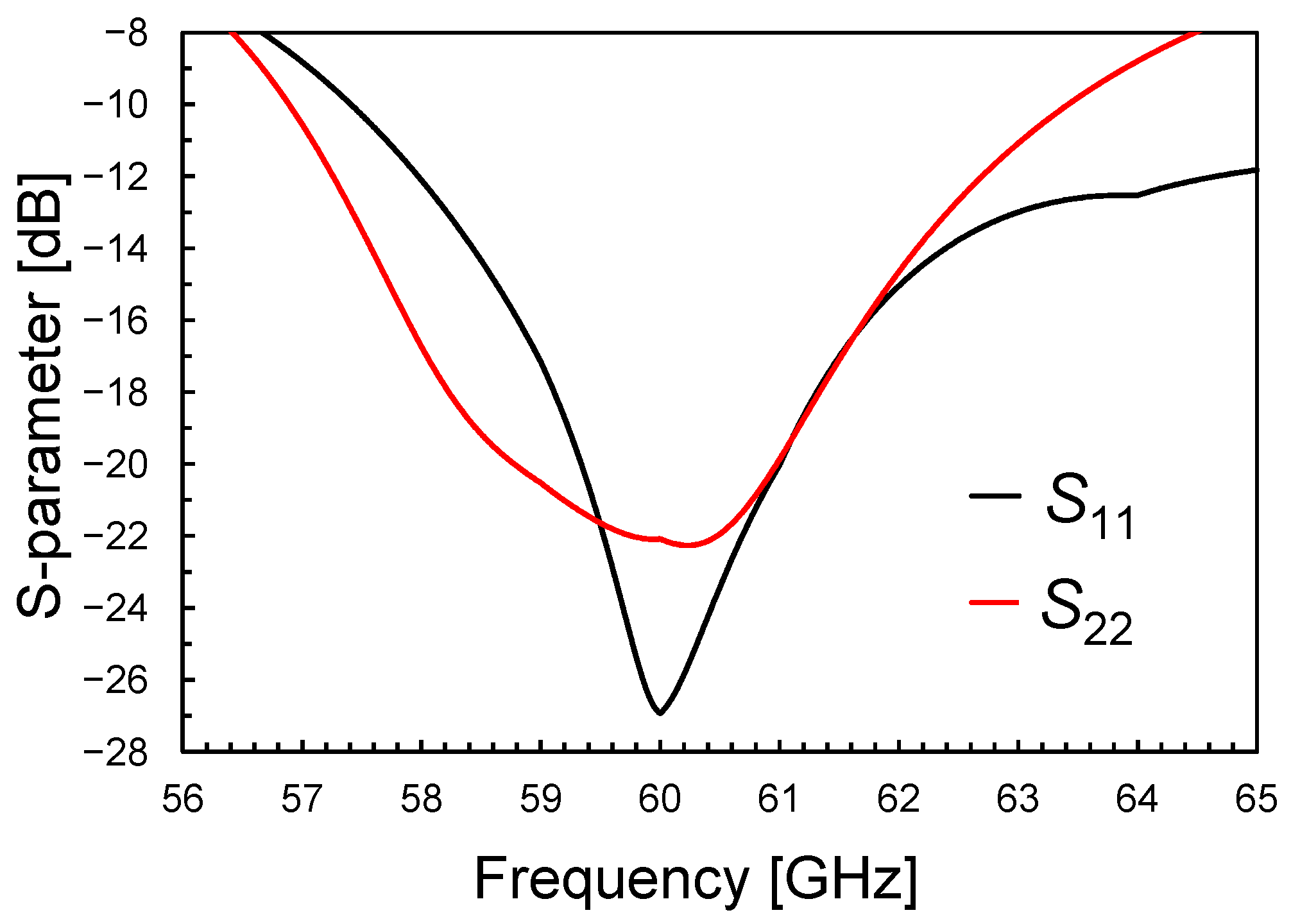
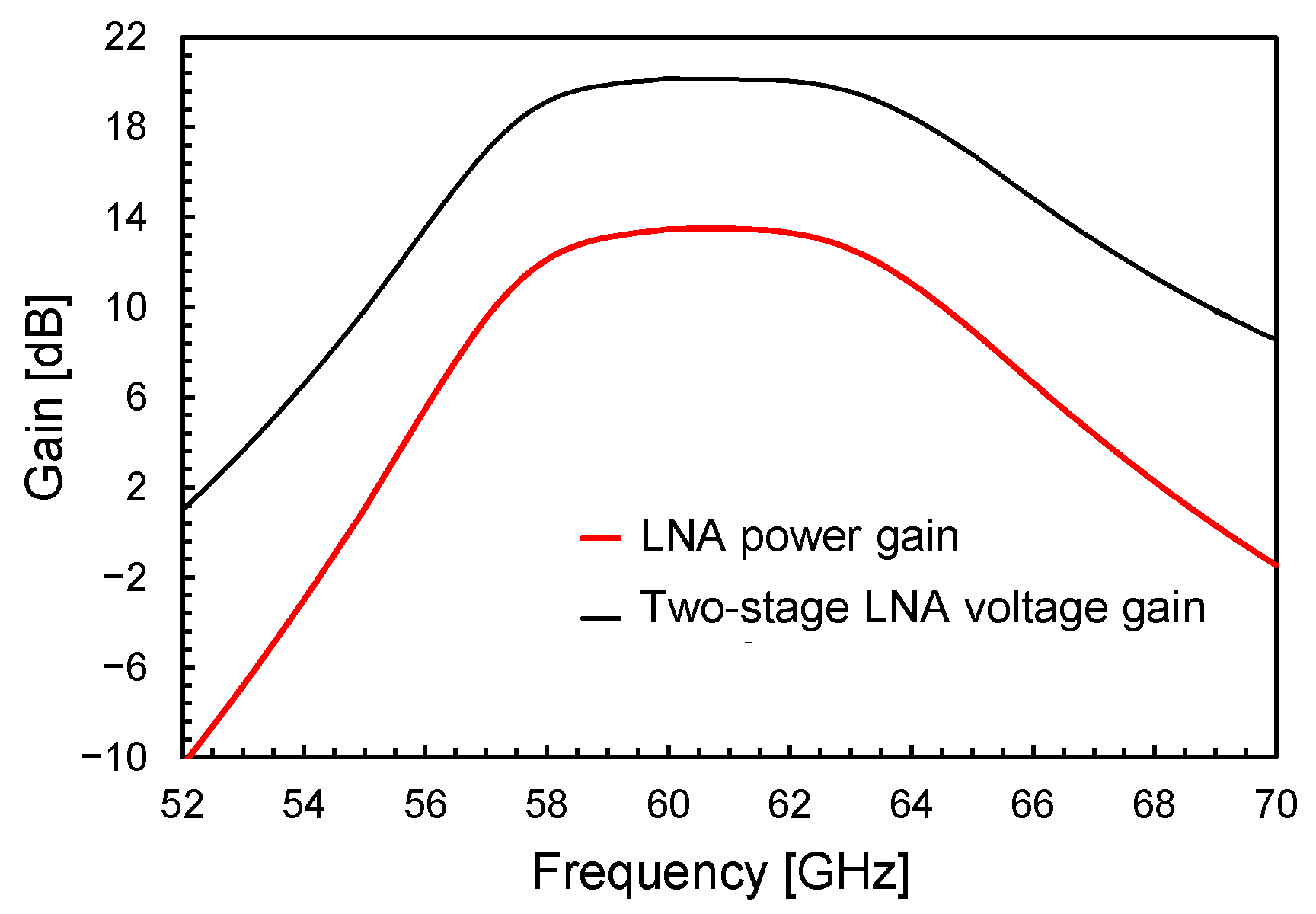
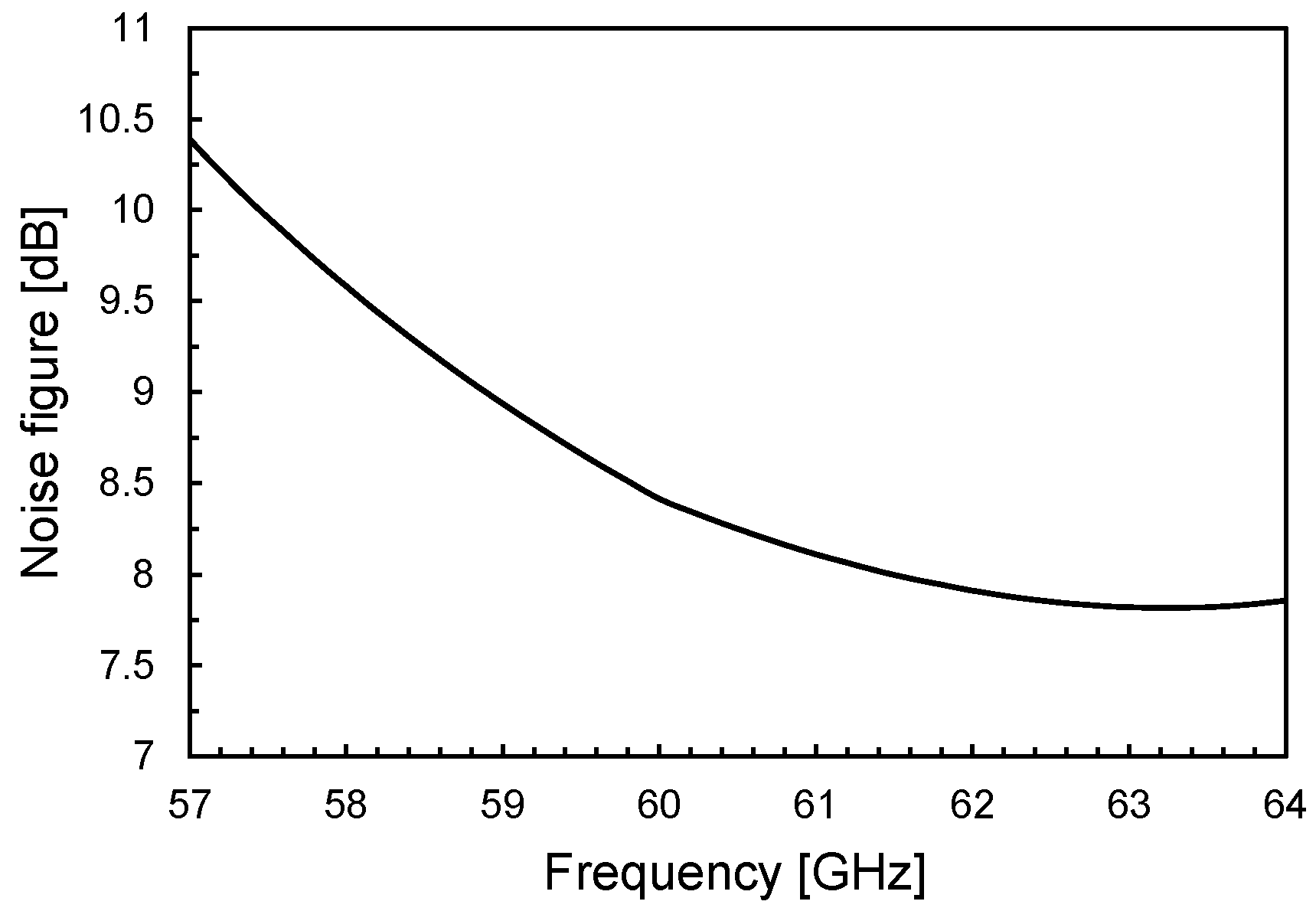
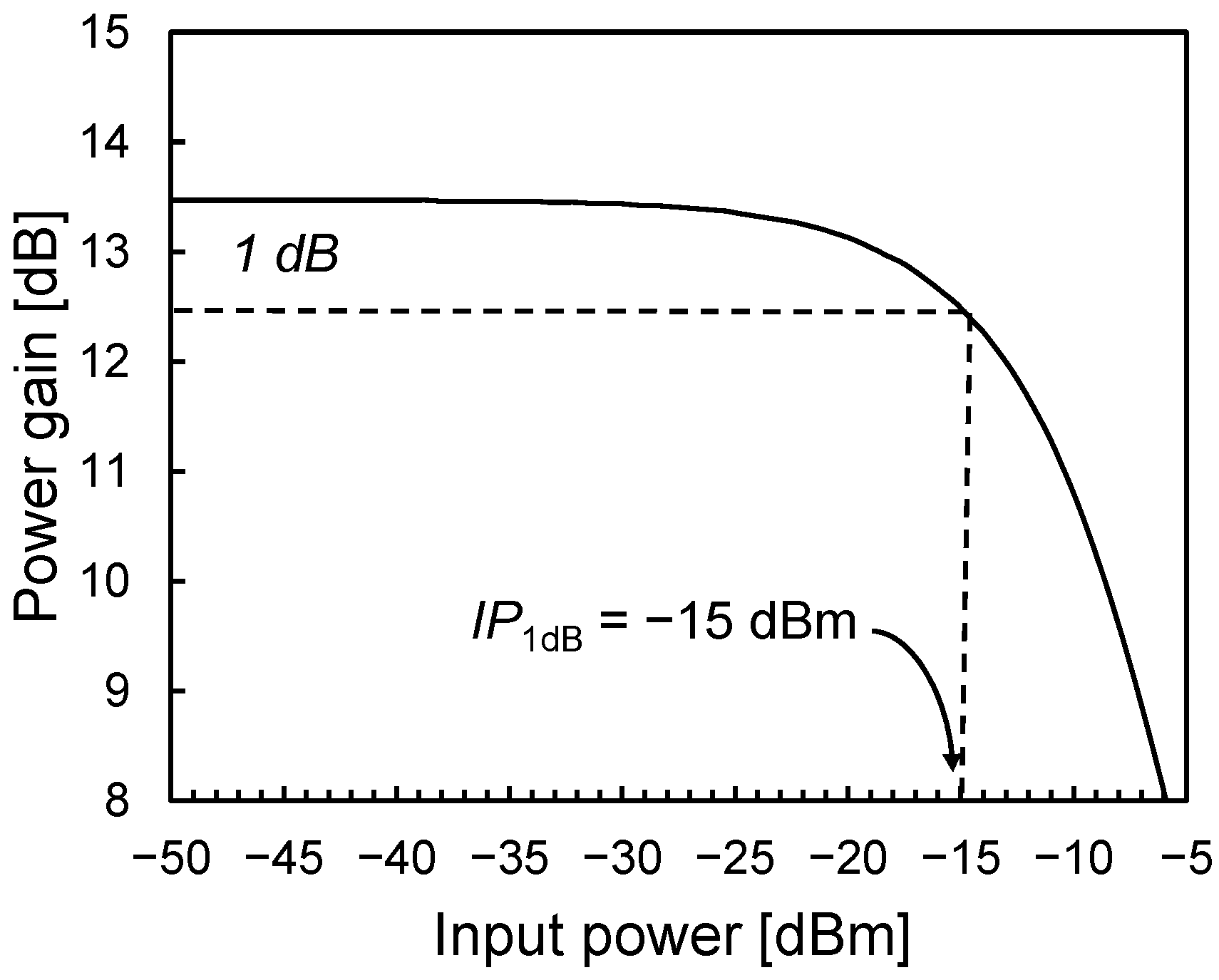


| Parameters | TIN (TBUF) | TINT | TOUT | Unit |
|---|---|---|---|---|
| Transformer topology | Stacked | Stacked | Stacked | |
| Primary/secondary inner diameter (dIN) | 22 | 58 | 63 | µm |
| Primary/secondary metal width (w) | 8/3 | 3/3 | 2/2 | µm |
| Spacing (s) | -/2 | - | - | µm |
| Number of turns (n) | 1:2 | 1:1 | 1:1 | - |
| Primary coil inductance @ 60 GHz | 47 | 151 | 173 | pH |
| Secondary coil inductance @ 60 GHz | 143 | 155 | 178 | pH |
| Primary coil Q-factor @ 60 GHz | 15 | 23.6 | 23.5 | - |
| Secondary coil Q-factor @ 60 GHz | 16 | 19.6 | 19.7 | - |
| Magnetic coupling factor (k) @ 60 GHz | 0.58 | 0.72 | 0.74 | - |
| Self-resonance frequency (SRF) | 144 | 121 | 112 | GHz |
| Parameters | [20], 2024 (M) | [21], 2020 (M) | [22], 2022 (M) | [23], 2022 (P) | [24], 2020 (M) | [19], 2012 (M) | This Work (P) |
|---|---|---|---|---|---|---|---|
| No. stages/topology | 1CAS-2CS | 3CS | 2CS | 2CS | 1CAS | 2CAS | 1CAS-2CS |
| Differential (d)/single-ended (s) | s | d | d | d | s | s | d |
| ESD protection/HBM level [kV] | NO | NO | NO | NO | NO | 3 | 2 |
| Center frequency [GHz] | 60 | 60 | 60 | 58 | 60 | 60 | 60 |
| NF @ center freq. [dB] | 4.4 | 5 | 7.1 (S) | 4.4 | 4.6 | 8.6 | 8.4 |
| Power gain (S21) @ center freq. [dB] | 16.8 | 25 | 16.1 | 22.7 | 14.1 | 10.2 | 13.5 |
| BW3dB [GHz] | 16.4 (50.6–67) | 7.5 (53.5–61) | 15 (52–67) | 9 (54–63) | 6 (57–63) | 10 (55–65) | 7 (57.3–64.3) |
| IP1dB [dBm] | −13 | −22 | −10 | −16.1 | −13.5 | −11 | −15 |
| Voltage supply [V] | 1.2 | 1.3 | 1.2 | - | 2.5 | 1 | 0.9 |
| Current consumption [mA] | 27.5 | 36.5 | 58.3 | - | 9.6 | 30 | 11.6 |
| Power consumption, PDC [mW] | 33 | 47 | 70 | 29.9 | 24 | 30 | 10.4 |
| CMOS process [nm] | 40 | 65 | 90 | 40 | 130 | 65 | 28 |
| FoM [14] | 2.46 | 1 | 0.57 | 2.01 | 0.98 | 0.45 | 1.10 |
| FoM1 [15] | 0.29 | 0.25 | 0.06 | 0.43 | 0.31 | 0.05 | 0.20 |
| FoM2 [16] | 4.76 | 1.84 | 0.84 | 3.90 | 1.87 | 0.54 | 1.38 |
| FoM3 [17] | 0.87 | 0.09 | 0.33 | 0.62 | 0.84 | 0.26 | 0.37 |
| FoM4 [18] | 238.54 | 11.64 | 83.56 | 95.61 | 83.57 | 43.25 | 43.53 |
Disclaimer/Publisher’s Note: The statements, opinions and data contained in all publications are solely those of the individual author(s) and contributor(s) and not of MDPI and/or the editor(s). MDPI and/or the editor(s) disclaim responsibility for any injury to people or property resulting from any ideas, methods, instructions or products referred to in the content. |
© 2025 by the authors. Licensee MDPI, Basel, Switzerland. This article is an open access article distributed under the terms and conditions of the Creative Commons Attribution (CC BY) license (https://creativecommons.org/licenses/by/4.0/).
Share and Cite
Eghtesadi, M.; Ballo, A.; Giustolisi, G.; Pennisi, S.; Ragonese, E. A 28-nm CMOS Low-Power/Low-Voltage 60-GHz LNA for High-Speed Communication. Electronics 2025, 14, 2819. https://doi.org/10.3390/electronics14142819
Eghtesadi M, Ballo A, Giustolisi G, Pennisi S, Ragonese E. A 28-nm CMOS Low-Power/Low-Voltage 60-GHz LNA for High-Speed Communication. Electronics. 2025; 14(14):2819. https://doi.org/10.3390/electronics14142819
Chicago/Turabian StyleEghtesadi, Minoo, Andrea Ballo, Gianluca Giustolisi, Salvatore Pennisi, and Egidio Ragonese. 2025. "A 28-nm CMOS Low-Power/Low-Voltage 60-GHz LNA for High-Speed Communication" Electronics 14, no. 14: 2819. https://doi.org/10.3390/electronics14142819
APA StyleEghtesadi, M., Ballo, A., Giustolisi, G., Pennisi, S., & Ragonese, E. (2025). A 28-nm CMOS Low-Power/Low-Voltage 60-GHz LNA for High-Speed Communication. Electronics, 14(14), 2819. https://doi.org/10.3390/electronics14142819










